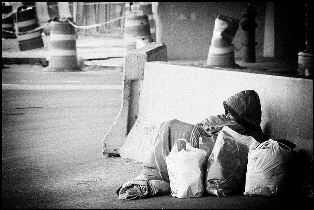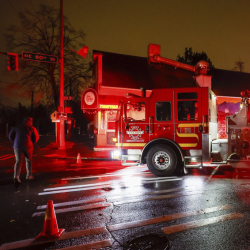 By Peter Schurmann, New America Media
By Peter Schurmann, New America Media
SAN FRANCISCO – At 18, Valerie Klinker was kicked out of her grandmother's house in San Francisco's Fillmore District. Despite being without a roof, alternating from parks to cars to SROs, Klinker says she never identified as homeless, a fact that, in the eyes of the city, made her all but invisible.
Indeed, advocates for homeless people here say there is a growing number of young African Americans who, like Klinker, are becoming homeless as the ongoing recession and nationwide trend of urban black flight erodes access to traditional safety nets. It's a trend, they add, that's happening largely under the city's radar.
"Today, 55 percent of [our clients] are black, compared to 1998, when that number stood at about 15-20 percent," said Rob Gitin, director of At the Crossroads (ATC). The outreach program, based in San Francisco's Mission District, primarily serves transitional age youth (TAY) between the ages of 18-24, too old for foster care but too young for many of the city's homeless programs.
Falling Through the Cracks
Coming from historically poorer neighborhoods in the city or from communities across the bay, such as Oakland and Richmond, many young people shy away from identifying as homeless, Gitin explained.
"But if you ask them where they're spending the night," he noted, "most couldn't say." In large part that's because the people they once relied on, such as family or friends, are no longer in a position to help, or just aren't there anymore.
According to a recent study by the Pew Research Center, the recession has inordinately affected blacks and Latinos. African Americans have seen a widening of the income gap compared to whites from 11 percent in 2004 to 20 percent in 2009. U.S. Census figures for 2010, meanwhile, show that San Francisco's black population has plummeted from 12 percent to just over three percent, mirroring trends nationwide.
"That stable aunt is no longer capable of providing for these people," said Ivan Alomar, who grew up in the Mission District and has worked as a counselor with ATC for six years. As a result, he said, a growing number end up without a roof over their head, homeless in all but name and invisible to city residents and service providers.
"It's possible the count missed them," acknowledges Noelle Simmons, referring to the city's biennial tally of those who are homeless, required of all jurisdictions that receive federal funding for homeless services.
Simmons, deputy director of policy and planning with San Francisco's Human Services Agency (HSA), which is responsible for tracking the city's homeless population, said volunteers simply identify those who are visibly homeless on the street, or are staying in shelters.
And that is a problem, said Alomar, who observed that most young blacks struggling to keep a roof over their heads "don't look homeless" and "don't use the word homeless" to describe their situation.
The latest count from January 2011, put San Francisco's homeless population at around 6,400, a slight decline from two years ago. Four in 10 were black, compared with one-third, who were white, and only one in eight, who were Latino. Simmons noted, however, that the large proportion of homeless African Americans here consisted of males between ages of 35 and 51, well beyond the TAY range.
Fewer Resources
"White kids have known stability, while Hispanics can rely on the support of family," explained Alomar. But he added that in the black community, becoming homeless is simply moving "from one form of instability to another."
Klinker, now a video editor and reporter with New America Media, said her grandmother kicked her out of the house on the suspicion that she'd gotten involved with drugs. Her mother wasn't around to care for her.
"I remember walking by people's doors in the SROs and seeing the occupants masturbating or shooting up," she recalled, referring to the single-room occupancy hotels common in low-income areas.
Despite her situation, Klinker, who now lives with her two kids and partner in the city's Hunters Point area, said she hid her homelessness from those she knew. "I didn't want pity," she stated, adding that she tried to keep up her appearance.
"There's a hell of 'em out there, and they look like me," Klinker emphasized, gesturing to her crisp hoodie top, jeans and sneakers, standard fare for most youth here.
Simmons said that while HSA is the city's main social service agency, it deals mainly with adults and families, leaving it to private organizations to care for youth in situations such as the one Klinker experienced.
But according to Amy Lemley, these organizations are "MIA in the advocacy arena."
Lemley is policy director with the John Burton Foundation, which, through its Homeless Youth Capacity Building Project, is looking to bolster the organizational and fundraising capabilities of the state's homeless youth service providers.
"In California, 5,000 kids age out of foster care every year," she said, adding that out of this number, 30 percent are African American. "They are being discharged from a system that does not have the resources to plan well for their transition," she noted, adding that the 20 percent unemployment rate for 16 to 24 year olds is the "highest since the state began keeping track."
Nevertheless, she said, there are fewer resources now for homeless TAY youth than there ever were before, and many in the homeless-advocacy field see the programs that are out there as "second rate."
The result, said Lemley, is that "almost no public funding" goes to these providers.
Youth "Growing More Desperate"
"It's a trend we've seen over the last couple of years," said Toby Eastman of Larkin Street Youth Services, speaking of the rise in homeless African American youth. Like Gitin and Lemley, Eastman said that the most pressing need for many of these individuals is stable housing.
But Eastman stressed that San Francisco has a "huge bottleneck" of those applying for transitional housing with a waiting list of 70 young people at Larkin. The latest transitional units recently opened in the city's downtown Tenderloin District. They are targeted to providing housing for youth with severe mental health issues.
In San Francisco's Bayview district, Aliya Sheriff is a therapist at 3rd Street Youth Center and Clinic, which provides local youth with medical and behavioral health services. Although not focused on homeless youth, she said that in recent years she's seen a "higher need for places to live" among her patients. Some have tried to pool resources in order to rent a place together, she said.
Sheriff also noted that as the recession economy increasingly taxes family resources, many youth are "becoming more desperate." Stress, sleeplessness and anxiety are on the rise, she said, as Bayview youth wrestle with questions about whether to "go to school, or go look for a job."
Crime is another option -- whether drugs or prostitution -- for making ends meet in a city where being homeless can often cost as much as staying housed. A night in an SRO usually runs around $60, Gitin points out, while constantly having to eat out for lack of a kitchen inflates what is an already high cost of living. For nights without a roof, he says, there's the local Carl's Jr. -- or a long bus ride with no particular stop.
New America Media's Donny Lumpkins contributed to this article.
Portland and Seattle
Free Subscription to Breaking News
Free Subscription to Breaking News




















































































































































































































































































































































